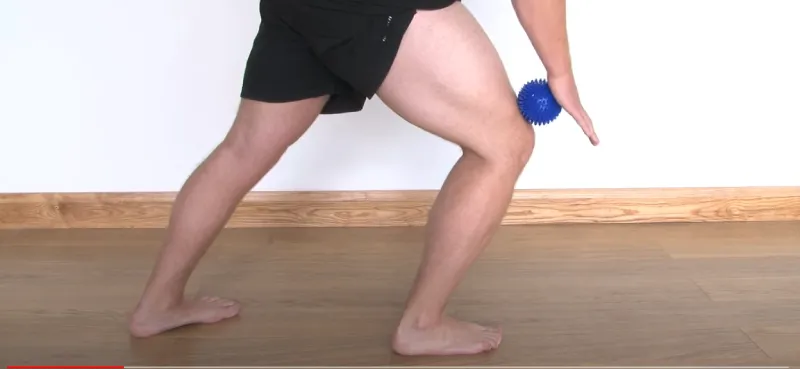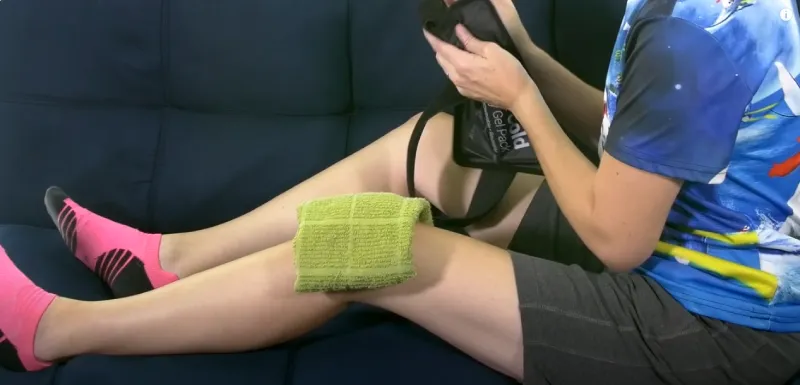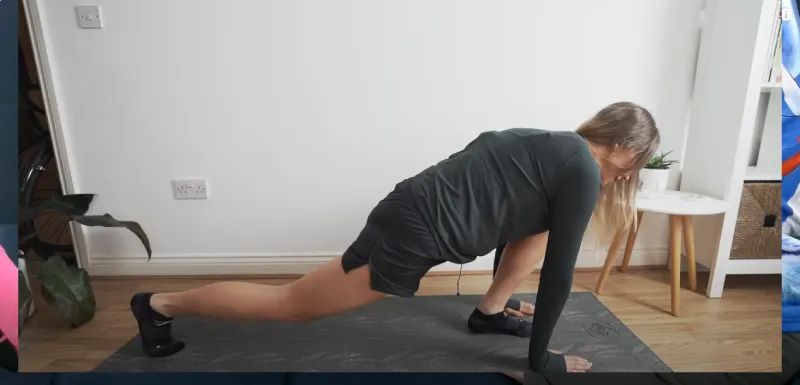Leg pain following cycling is called ‘DOMS’ or Delayed-Onset Muscle Soreness. If overstressed, the muscle can increase in size to exert pressure on the sciatic nerve, damaging muscle fibers in the leg or hip–which is why it’s a common cause of sciatica.
To Relieve leg pain after cycling, do light exercise, stretch, and use a foam roller. These activities boost blood flow and release endorphins.
Try ice baths, packs, a pre-bed warm salt bath, and a hot pad while sleeping for relief. Active recovery temporarily soothes discomfort caused by DOMS, according to research.
In this blog, we’re diving deep into post-cycling leg pain recovery. We’ll explore everything from immediate remedies to lifestyle changes that can help keep your legs feeling as fresh as a daisy, even after the toughest rides.
How To Relieve Leg Pain After Cycling: 7 Expert Tips
After a good cycling session, this is usually because your muscles are recovering from the workout. It’s common to feel discomfort or soreness in your legs, often because of delayed onset muscle soreness (DOMS). This guide delves into expert insights and proven strategies to ease leg pain, ensuring your cycling adventures are enjoyable and pain-free.
Foam Rolling Techniques
These are great for targeting large muscle groups like quads and calves. You can control the pressure and roll out tightness and muscle knots using your body weight. Let’s focus on the benefits of foam rolling.
A foam roller is like a massage for your muscles. It helps in several ways:
- Reduces muscle tightness: Rolling over those tight spots helps loosen the muscles.
- Increases blood flow: It moves the blood to your muscles, speeding up recovery.
- Helps with flexibility: Regular foam rolling can make your muscles more flexible.
Techniques for Targeting Sore Muscles Effectively
You can maximize foam rolling’s benefits by following these helpful tips to enhance your experience and improve your results:
- Start gently: If you’re new to foam rolling, it might initially feel uncomfortable. Start with light pressure and gradually increase as you get used to it.
- Focus on sore areas: Pay special attention to painful areas. Roll slowly over these areas.
- Don’t rush: Spend at least a few minutes on each leg. Rushing through it will give you only a portion of the benefits.
- Breathe: It sounds simple, but remember to breathe deeply as you roll. This helps your muscles relax even more.
The benefits of foam rolling can be significant in terms of reducing recovery leg pain from cycling. Incorporate it into your post-ride routine to get rid of leg pain immediately. You’ll be able to recover quicker and reduce soreness, which means you’ll be ready and eager for your next ride sooner rather than later.
Massage and Self-Massage Tools

Leg pain can sometimes follow a long, fulfilling ride on your bicycle. But don’t let this discomfort deter you from enjoying your cycling adventures.
One of the most effective ways to ease this pain is by self-massaging. Let’s delve into the benefits of massage after cycling and explore some tools to help you perform self-massage effectively.
Benefits of Massage Post-Cycling
Massage isn’t just a way to pamper yourself; it offers many benefits, especially for cyclists:
- Enhances Recovery: Massage helps speed recovery by increasing muscle blood flow, bringing nutrients and oxygen needed for repair.
- Reduces Muscle Soreness: It can help reduce the intensity of muscle pain after cycling, making it easier to get back on the bike sooner.
- Improves Flexibility: Regular massage can increase flexibility by stretching and lengthening the muscle fibers, leading to improved performance and reduced risk of injury. In the case of cycling, there is no conclusive evidence that it increases leg length beyond 18 years of age.
- Relieves Stress: Beyond the physical benefits, massage also has a calming effect on the mind, helping to relieve stress and improve overall well-being.
- Relieve Nerve Pain: A massage helps to reduce the effects of injury by relieving the compression of nerves and encouraging the repair of damaged nervous tissues to increase. Relief of compressed nerves and healing of damaged nervous tissues reduces negative sensations.
Overview of Tools That Can Be Used for Self-Massage
Professional massages are lovely, but they may only sometimes be practical because of time or budget constraints. Fortunately, there are several tools available that can help you perform effective self-massage at home:Professional massages are lovely, but they may only sometimes be practical because of time or budget constraints. Fortunately, there are several tools available that can help you perform effective self-massage at home:
- Massage Sticks: These handheld tools are perfect for more targeted work and can reach areas that might be difficult with a foam roller, such as the inner and outer thighs.
- Massage Balls: Massage balls (or even a simple tennis ball) can work wonders for deep, pinpoint relief. They’re perfect for targeting the glutes, hips, and areas around the shins.
- Electronic Massagers: Various electronic massagers, from percussion to vibrating foam rollers, are on the market. They offer a range of intensities and settings to suit your needs.
Cool Benefits of Cold Therapy
Have you ever wondered why athletes sometimes take ice baths or use ice packs after a big game or intense workout? This method, known as cold therapy, has some cool benefits that help the body recover. After pushing your limits, let’s dive into why it might be a good idea to chill out with some cold therapy.
Ice Baths: Taking the Plunge for Recovery
Imagine finishing a long bike ride; your legs are tired and achy. Now, picture yourself in a tub filled with cold water and ice. Sounds intense. But here’s why try it:
- Soothes Muscle Soreness: Ice baths can help reduce the soreness you feel after cycling by calming down your inflamed muscles.
- Speed Up Recovery: They can also help your muscles heal quicker. This means you can return to your cycle sooner without feeling much pain.
- Boosts Circulation: After you step out of an ice bath, your body warms up again. This process helps increase blood flow to your muscles, which is suitable for recovery.
Ice Packs: Targeted Cold Comfort
Unlike an ice bath, ice packs are a less daunting alternative, which may send shivers down your spine. Here’s why they’re handy:
- Pinpoints Specific Areas: You can place ice packs on the areas of your leg that hurt the most. This targeted approach ensures that relief is delivered right where you need it.
- Easy and convenient: Ice packs are super simple to use. You can even wrap one around your leg while relaxing on the couch.
- Reduces Swelling: If you notice any leg swelling after cycling, an ice pack, thanks to its cold temperature, can help bring it down.
Warm Up to Wellness: The Benefits of Heat

With great rides come significant responsibilities, mainly taking care of your legs afterward. If cold therapy isn’t quite your speed, don’t worry. Warm treatments can also offer comforting relief for those aching muscles. We’ll explore how warm salt baths and hot pads during sleep can soothe your sore legs after cycling.
Warm Salt Baths: A Soothing Soak
After pushing the pedals for miles, treating yourself to a warm salt bath can be a luxurious way to ease muscle discomfort. Here’s why it works:
- Relaxes Muscles: The warmth from the bath helps relax and loosen tight muscles, providing immediate relief.
- Reduces Soreness: Epsom salts, commonly used in warm baths, contain magnesium, which is believed to help reduce muscle soreness and relieve cramps.
- Promotes Sleep: Indulging in a soothing bath before bedtime can enhance sleep quality, a vital factor for effective muscle recovery.
Hot Pads: Overnight Healing
Hot or heating pads while you sleep are another effective way to address leg pain. Consider these benefits:
- Continuous Relief: A hot pad relieves severe leg pain at night. It provides consistent warmth, keeping your muscles relaxed all night.
- Targets Specific Areas: You can place hot pads directly on the parts of your legs that feel the most tired or sore.
- Improves Blood Flow: The heat encourages blood circulation to the affected areas, aiding healing.
Tips for Using Warm Treatments Safely
While warm treatments can be incredibly beneficial, you should always use them correctly to avoid any potential problems:
- Don’t Overdo It: Limit your warm salt baths to about 20 minutes to prevent skin irritation or excessive dehydration.
- Check the Temperature: Ensure your bath water and hot pads are comfortably warm but not scalding to avoid burns.
- Stay Hydrated: Warm treatments can make you sweat, so drink plenty of water to keep yourself hydrated.
Stretching and Flexibility Exercises

Cycling is an exhilarating activity that fills you with freedom and accomplishment. It can also leave your legs feeling sore or stiff. Luckily, incorporating stretching and flexibility exercises into your routine can significantly help. Let’s explore specific stretches that ease soreness and enhance your cycling experience.
- Improves Flexibility: Regular stretching makes your muscles more flexible, improving your bike performance.
- Reduces Pain: Stretching helps relieve muscle tightness and soreness that you might feel after a long ride.
- Prevents Injury: Flexible muscles are less likely to get injured. Stretching both before and after riding can keep those pesky injuries at bay.
Essential Stretches After Riding
After your ride, it’s time to cool down and stretch out those worked muscles:
- Hamstring Stretch: Extend one leg out while sitting on the ground. Reach toward your toes. Switch legs. This will help loosen your hamstrings.
- Butterfly Stretch: Put your feet together and nuzzle your knees with your elbows. This is great for your inner thighs and hips.
- Lower Back Stretch: Lie on your back, pull your knees to your chest, and hold. This relaxes your lower back, which can get tight during cycling.
Tips for Effective Stretching
To get the most out of stretching, keep these tips in mind:
- Take Your Time: Take your time with your stretches. To loosen your muscles, hold each stretch for a minimum of 30 seconds.
- Breathe: Deep, slow breaths help your muscles relax during each stretch.
- Listen to Your Body: Stretching should feel good, not painful. If something hurts, ease up a bit.
To Relieve Leg Pain After Cycling: 5 Nutritional Strategy
The quality of your diet plays a crucial role in the speed at which your body recovers after cycling. Focusing on specific nutrients can help reduce inflammation, repair muscle tissue, and get back on your bike feeling strong. Here are some critical components of a nutritional strategy aimed at preventing DOMS:
Antioxidants: Your Allies Against Inflammation
- Why They’re Important: Antioxidants fight against inflammation in your body, which can result from intense cycling sessions.
- Where to Find Them: Eat fruits and vegetables like oranges, berries, spinach, and kale. These foods are packed with antioxidants.
Healthy Fats and Omega-3s: Keeping Cells Strong
- Muscle Cell Health: Fats are crucial in maintaining cell integrity, meaning they help keep your muscle cells healthy.
- Omega-3 Power: Omega-3 fatty acids in fish like salmon and flaxseeds are good at reducing inflammation and promoting muscle repair.
Vitamins D: A Key Agent in Muscle Repair

- Why It Matters: Eating a balanced diet rich in vitamin D supports bone and reduces the risk of bone pain in the legs.
- Sources of Vitamin D: While sunlight is a significant source, fortified products, fatty fish, and egg yolks are also excellent sources.
Protein Intake: The Building Blocks for Recovery
- Protein’s Role: Protein is essential for muscle recovery. The nutrients it provides are crucial for your body’s ability to repair and strengthen muscle tissue.
- How Much You Need: Aim to include a source of protein in every meal. Good options include chicken, tofu, beans, and dairy products.
Tips for Implementing These Changes
- Balance is key: Ensure your diet is diverse and encompasses many foods to get all the essential nutrients your body requires.
- Stay Hydrated: Dehydration causes unwanted leg cramps and leg pain. When dehydrated, blood flow decreases, starving these muscles of much-needed nutrients. Maintaining good health requires adequate hydration, which can help with muscle recovery.
- Plan: Prepare meals and snacks to ensure you get the right nutrients after your cycling sessions.
Conclusion
To my fellow cyclists, having delved into a myriad of tips and tricks to ease those leg pains, we are now better equipped to continue our love for cycling! Our exploration has led us to various remedies, ranging from post-ride essentials like foam rolling and massages to the advantages of cold therapy and warmth.
Our journey continues beyond there. We have also embraced flexibility exercises to enhance our recovery process and adopted a nutrition plan abundant in antioxidants, healthy fats, Vitamin D, and proteins.
FAQs
What Should I Drink After Cycling For Recovery?
Clif Chocolate Recovery Mix: This mix combines Plain Whey Protein with lemon-lime Gatorade Powder, Malto Dextrin Powder, and Whey Protein Powder. It also includes Dairy-Free Protein Powder and Chocolate Milk.
How To Get Rid Of Lower Leg Pain Immediately?
Start by resting and elevating your leg to relieve lower leg pain immediately. Apply ice for up to 15 minutes and gently stretch or massage the affected muscles. Consider taking over-the-counter pain medication like acetaminophen or ibuprofen for relief.
Can A Broken Toe Cause Leg Pain?
Yes, a broken toe can cause leg pain in a cyclist because of altered gait and weight distribution. The body may compensate by shifting pressure to other areas, straining leg muscles and causing discomfort. This altered walking pattern can trigger pain and discomfort in the leg because of the broken toe.
Why Do My Legs Ache After Cycling?
Your legs ache after cycling due to DOMS (delayed-onset muscle soreness) caused by exercise-induced muscle damage. Symptoms typically appear 48-72 hours post-exercise and can last several days. This discomfort is a sign of muscle repair and adaptation to the physical stress of cycling.
How To Recover From A Long Bike Ride?
To recover from a long bike ride, remember to cool down, elevate your legs, hydrate with cycling recovery drinks, and fuel up on carbs and protein. Additionally, consider self-massage, mobility work, and wearing compression clothing to aid recovery. Lastly, prioritize rest by getting quality sleep and allowing your mind to relax.
Have You Got Sore Thighs From Cycling?
Yes, thighs hurt after cycling are common due to lactic acid accumulation in the quadriceps from the intense pedal power. Lactic acid buildup can lead to pain in the back of the thighs and calves. Additionally, delayed onset muscle soreness (DOMS) from microscopic tears in the muscles can cause achy feelings post-exercise.
Why Does It Hurt When I Ride A Bike?
Your bike may hurt due to an incorrect position, causing aches and pains. Check cleat, handlebar, saddle position, and stem length. Adjusting these can help alleviate discomfort.
Is Your Quads Sore From Cycling?
Due to the repetitive engagement of the quadriceps muscles during cycling, there can be quad soreness after cycling. Spending extended periods on a bike can lead to stiffness and achiness in your quads. Incorporating stretches and recovery strategies can help alleviate the discomfort.

![5 Solutions For Leg Pain After Cycling: 5 Nutritional Strategies [DIY]](https://cacyclinghub.com/wp-content/uploads/2024/05/How-To-Relieve-Leg-Pain-After-Cycling-2-e1717585497549.webp)
